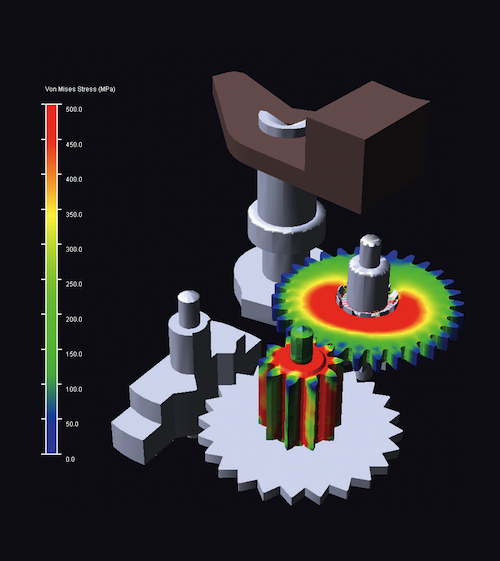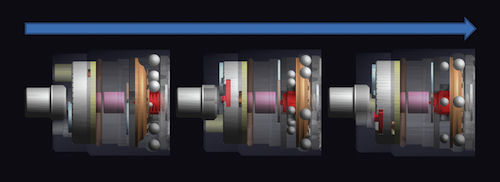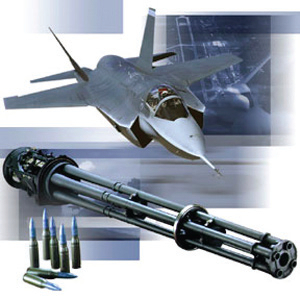By Scott Bradley, Design Modeling, and Simulation Lead System Design, Evaluation Ltd. Hertfordshire, UK
In the design of almost any new high explosive ammunition, the most complex and often problematic component is the fusing system. The fuse must incorporate a Safe and Arm device to ensure that the projectile may only enter the armed state following exposure to firing forces and after reaching a safe distance from the muzzle of the weapon. Engineers at System Design Evaluation (SDE) have constructed rigid and flexible body MSC Adams models to study the motion and strength of the design of fuse mechanisms to identify potential design issues and assist with analysis of trial results.
“Conducting live firing ammunition trials is an expensive business,” said Eva Friis, Project Manager for the APEX ammunition development program at Nammo Raufoss in Norway. “Analysis of recovered fuses to determine the cause of failure is little short of forensic science and it is difficult to know how the forces imposed during recovery of the projectile affect the results. The Adams simulations have provided an insight into the operation of the fuse and enabled the team to highlight and address weaknesses with the design before manufacture and physical testing.”
The Nammo 25 mm APEX projectile is a next-generation armor-piercing, high explosive ammunition designed for use with the US F-35 Joint Strike Fighter aircraft. The projectile leaves the muzzle of the four-barreled GAU-12 weapon system with a velocity of approximately 1,000 m/sec and experiences a peak setback acceleration of almost 80,000 g. Under these conditions, coupled with severe space restrictions, it is almost impossible to instrument the fuse to gain an understanding of the operation and interaction of components inside. Therefore, while physical testing can be used to confirm function, it often offers only limited information for post analysis in the event of a failure.

A detailed Adams flexible body modeling of a fuse escapement mechanism allows you to see stress results in real-time.
Adams modeling has proven invaluable in providing information to assist with the diagnosis of evidence gained from recovery tests. In one case, examination of the internal fuse components after recovery tests showed markings that indicated a malfunction had occurred.
A detailed flexible body Adams model of the design was developed, and analysis confirmed the nature of the problem and sequence of events within the fuse mechanism; huge centrifugal forces due to projectile spin resulted in deformation of internal components sufficient to unlock two retaining gears.
Computer modeling of ammunition fuses has not been without challenges. Safe and Arm devices are often mechanical and operate using clockwork escapement mechanisms, similar to those found in wrist watches. Such mechanisms rely heavily on 3D contact, leading to extended run times. Further, fuse arming times are largely dependent on the definition of frictional algorithms within the models. SDE has worked closely with fuse manufacturers to overcome this and validate models against static spin tests thereby providing a firm basis from which to investigate further design permutations.
Engineers at SDE began providing computer aided engineering (CAE) support to the Nammo Raufoss APEX development program during the conceptual design phase. Early Safe and Arm fuse modeling work was undertaken using rigid body kinematic analysis software. However, customer requirements to undertake combined analyses of component strength within more complicated assemblies prompted a search for replacement software.
Numerous commercially available packages were evaluated but none were found to offer the flexibility of Adams in allowing rapid and fully integrated analysis of both the kinematic function and strength of design of complex mechanical systems.
The Adams flex-to-flex contact capability has aided significantly in simplifying the modeling of the escapement systems commonly found in mechanical Safe and Arm devices. In particular, due to the reciprocating nature of the regulator component, considerable forces may be dissipated throughout the gear train. This can sometimes lead to catastrophic failure of the components due to shearing of gear teeth, resulting in premature arming of the fuse. The parts of such mechanisms can be modeled as flexible bodies within Adams allowing an assessment to be made of the stresses and strains developed in each part during operation.

An Adams rigid body modeling of a fuse impact delay mechanism to determine sensitivity to impact at various velocities, angles, and with different materials.
The Adams results have not only successfully predicted the failure of components on numerous occasions within various fuse designs, but have also facilitated in the redesign of components to achieve suitable strength. Importantly, by quantification of stresses within components, Adams has assisted in proving compliance with required safety factors, information which is not possible to glean from live firing trials results.
The APEX fuse is designed to provide a short delay, after impact, before initiating the high explosive fill to allow the projectile to first penetrate the target and deliver maximum blast and fragmentation effects inside. To achieve this, the impact delay mechanism must be robust but sufficiently sensitive to normal and oblique impact angles. SDE have used Adams, coupled with hydro-code predictions of axial and spin deceleration, to simulate the motion of the impact mechanism and assess the sensitivity of the fuse to impacts with various target materials at different impact velocities and angles of obliquity.

The Nammo 25mm APEX projectile is an armor-piercing, high explosive ammunition for use with the US F-35 Joint Strike Fighter aircraft.
The sensitivity of the fuse is critical to ensure a high probability of success. Through the use of Adams to simulate and optimize the design of the impact mechanism, the successful function of the Nammo 25 mm APEX round against a wide range of targets is assured.
“Adams has played a significant role in identifying and quantifying the magnitude of issues in one of the most technically challenging areas of ammunition design. The software has provided guidance to the design and development effort, reducing the number of expensive trials required and the overall cost of the development program,” added Friis.
MSC Software
www.mscsoftware.com
Filed Under: Aerospace + defense, Software • FEA, Software • simulation, ENGINEERING SOFTWARE, Fuses





Tell Us What You Think!